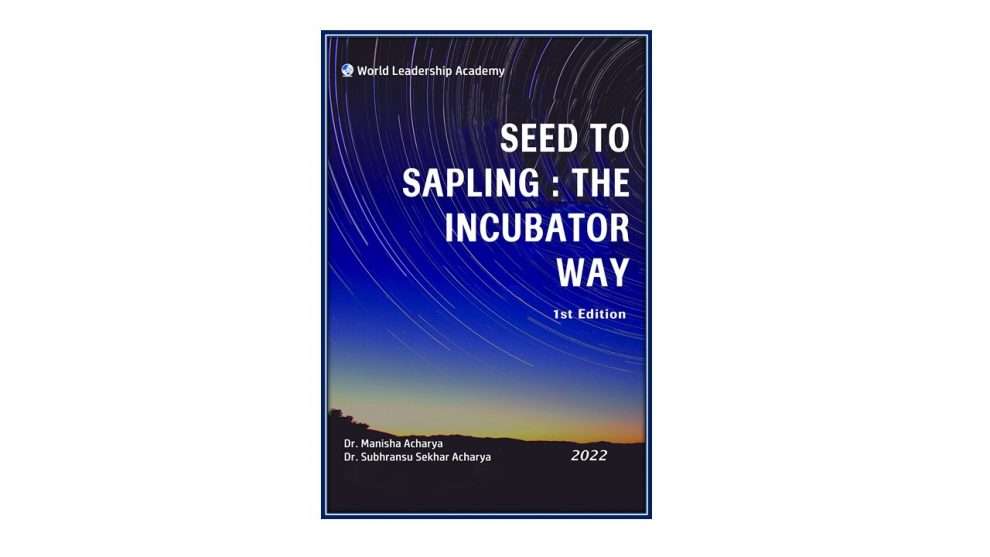Manisha Acharya and Subhransu Sekhar Acharya (2022)
Publisher : World Leadership Academy
Language : English
Hardcover : 108 pages
ISBN : 978-93-94318-05-2
Price : INR 399 (Hardcover)
The book, Seed to Sapling: The Incubator Way by Manisha Acharya and Subhransu Sekhar Acharya opens up the delight of walking with an idea to creating an entrepreneur-led enterprise through an incubator. A slim ready reckoner spread over 10 chapters, it travels from the seeding of an idea to the fruiting of a venture grown through the nurturing platform of an incubator.
The authors – new age innovation professionals for the last decade – use their experience to bring forth a much-needed treatise of ‘dos and don’ts’ on ideation, prototype making, and starting an enterprise through the platform of incubation centres that function as the fuelling agents of entrepreneurship. True to its title, this book begins with the conception idea and elicits vividly and clearly the conceptual background for ideation and innovation-led entrepreneurship, up to Chapter 4. In this fast-evolving ecosystem, grounding of concepts in a sequential manner for better understanding and planning of a successful enterprise is defined across several platforms. It is important to understand the theoretical basis of this exciting journey. Accordingly, the discussions in these chapters focus on idea scouting, its evaluation and its plunge into the start-up-entrepreneurship trail. Indeed, this is the USP of this book.
With this understanding of the basic tenets of the innovation process, the stage is set to capture and understand the opportunities emerging across the ecosystem, and then explore the dependable roles played by several institutions. Identification of such points of support is a critical step for any aspiring entrant into the innovation system, and the authors have brought this out in a creative and vivid manner. Additionally, Chapter 3 clearly defines and identifies what comprises a start-up along with types of start-ups emerging in the ecosystem. An illustration of the life cycle of a typical start-up theoretically captures all stages very well. But adding real-time examples along with this description would perhaps have enriched it. This would have held tighter the reader’s interest, motivated aspiring entrepreneurs, and thus captured a larger readership. For instance, the description on how innovation can be driven to build a path to a winning spree in Chapter 4 sparks particular interest with examples of classically well-known inventions built into innovations benefitting societies all through.
Chapter 5 starts with a discourse on incubation architecture and its elements. Current options for a legal structure and comparative tabulation of available choices is tactfully presented. Certainly, such information is useful for all institutions planning to establish incubation centres. This is something current CEOs of such centres or several others working in this space did not get to access, especially for aiding their decision-making processes while developing incubator centres. Any well-documented brief on such options would have allowed potential entrants or practicing administrators of incubation centres to make their choices on establishing and developing best practices for the operations of incubation/innovation centres. That is why Chapters 6 to 8 – detailing each of the steps for setting up incubators – is a good piece of ready advice useful to several universities and institutions thinking of building strong innovation and incubation systems. The well-researched information given in these chapters is both simple and compelling.
Lastly, Chapters 9 and 10 offer more academic matter defining the model of sustenance and possible Monitoring and Evaluation (M&E) factors of an incubator centre. It is an accepted fact that since the incubation ecosystem in India is yet in an early stage, producing impact indices will call for more detailed and systematic M&E.
Perhaps, the most interesting part of the book is the last section, the ‘Epilogue’ that captures stirring stories of two start-ups and their growth though their incubation processes. Both women founders have their own personal compulsions and passion to be part of their respective entrepreneurial journeys. Both attribute the trajectories of their progress to the ‘catalysing ecosystem’ of their incubators. However, the success stories are more generic and anecdotal, lacking in nuances and modes of the association through which they benefitted.
Indeed this book, Seed to Sapling: The Incubator Way does provide a comprehensive, yet concise, insight into the ideas necessary for scouting and developing a platform for the Indian incubation ecosystem. Its publication is timely, capturing the entire process from seeding to sapling. It is important that the documentation of the nurturing process of ‘sapling to fruiting’ also be attempted soon, so that a 360-degree view of incubation and innovation ecosystem is available. The book itself has an easy-to-read style with some real-time examples; the simple, succinct language enthrals even a lay audience, including inventors, scientists, entrepreneurs and many others.
Overview: Recommended. An interesting, easy, and thought-provoking read, which gives current insights on emerging trends and options available across the innovation landscape in India. Finally, as a person deeply involved in managing an incubator this book would be the first choice to give to all novice entrants coming into a start-up incubator or as part of the management team of an incubator!
R Kalpana Sastry
 Dr R Kalpana Sastry, is currently Managing Director at AgHub Foundation, Professor Jayasankar Telangana State Agricultural University (PJTSAU), Hyderabad. She is a distinguished Agricultural Scientist with nearly three decades of expertise in the areas of Agriculture Research, Technology Commercialization, Intellectual Property and Innovation Management, Entrepreneurship and Start-up Ecosystem Development in Agriculture. She can be reached at: kalpanas.regulagedda@gmail.com
Dr R Kalpana Sastry, is currently Managing Director at AgHub Foundation, Professor Jayasankar Telangana State Agricultural University (PJTSAU), Hyderabad. She is a distinguished Agricultural Scientist with nearly three decades of expertise in the areas of Agriculture Research, Technology Commercialization, Intellectual Property and Innovation Management, Entrepreneurship and Start-up Ecosystem Development in Agriculture. She can be reached at: kalpanas.regulagedda@gmail.com





Add Comment